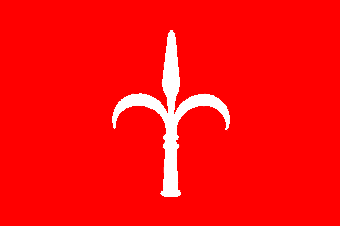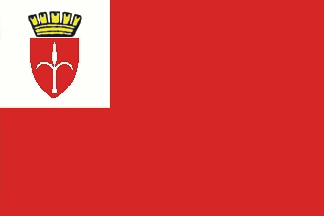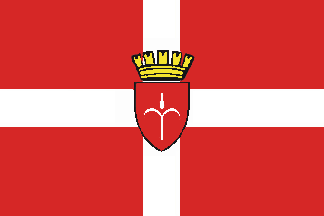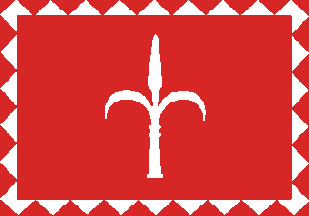 image
by Alex Belfi, 3 October 2000
image
by Alex Belfi, 3 October 2000
Last modified: 2021-08-24 by rob raeside
Keywords: italy | friuli-venezia giulia | trieste | spearhead | istria | free territory | spear | helberd |
Links: FOTW homepage |
search |
disclaimer and copyright |
write us |
mirrors
 image
by Alex Belfi, 3 October 2000
image
by Alex Belfi, 3 October 2000
See also:
I believe the red flag with the white halberd was the flag for the whole territory since
the constitution of the Free Territory of Trieste mentioned the
flag of the Territory as well as the coat of arms. But the flag
was certainly mainly used in the city of Trieste as this flag is
first a city flag.
Pascal Vagnat , 25 September 1998
The flag was in use as Free Territory of Trieste flag from
1945 to 5 October 1954.
Jaume Ollé , 5 November 1998
I was wondering, was this the flag of FTT Zone A, that is under
Italian/Allied control. I have never seen (or can't remember) reference to such
flag used in FTT Zone B, that is one that was under the administration of
Yugoslav Army (i.e. Tito's partisans). Actually, I never heard of any flag
ascribed to FTT Zone B. However, most probably the well known Yugoslav flag with
stars, as well as the national flags with stars (Slovenian, Italian and Croatia)
would have been used. And, of course, the red flag of Communist party .
The two zones of FTT were later (1953, IIRC) incorporated in Italy and
Yugoslavia respectively, with very minor border changes. FTT Zones issued both
stamps and banknotes. I do not remember them quite vividly to claim anything,
but there was not FTT flag or coat of arms on them. I seem to remember one FTT
Zone B stamp with flag, but that one was pure red.
eljko Heimer, 24 September 1998
In the Belgian vexillological magazine Vexillinfo no. 58 (March
1985), Aldo Ziggioto from Italy explains that he was in
Trieste in 1945. On the First of May, the whole of the territory was
occupied by Yugoslav troops. In June, these had to leave
Trieste which was then occupied by the Western Allies. Since that
time, the territory was divided in two parts: the A zone (Trieste
and surroundings: Allied Military Government, then Free Territory
of Trieste) and B zone (part of Istria,
governed by the Yugoslavs).
On paper, the two zones formed together a territory with an
autonomous administration. In reality, Yugoslavia immediately
considered the B zone as a "free" zone and annexed it
to the Popular Republic of Yugoslavia.
Ziggioto says that in the B zone, the Italian tricolour was
strictly forbidden, except when, but rarely, it bore a red star
fimbriated gold in the middle (see
here). On the other hand, the Slavs, who were relatively
numerous in Trieste and in its surroundings, lived in a
"democratic state" and could freely use the Yugoslav
flag during demonstrations. In fact nobody knows if there was a
specific flag for the Free Territory of Trieste, for there
was only one "Trieste" flag made: the unique exemplar
of the flag was flying above the castle of Duino.
In Flagmaster 043 and Vexillinfo no. 48 of May 1984 p.51, another information: Mr. J.R. Allen says at first the
flag of the Free Territory of Trieste was also flying only in the
A zone occupied by the American-British forces and especially
above the castle of Duino, which was the residence of the
Military Cdt of the said zone, the General Officer Command
BETFOR (British Element Trieste Force). The flag was lowered on
the 5th of October 1954 when the Italians regained this part of
the territory. It is kept now in the collections of the Imperial
War Museum in London.
Pascal Vagnat , 13 November 1999
As far as I'm aware, it is true that there was no specific
flag for FTT. Zone B was not "immediately annexed", at
least not in theory- it formed separate zone under military
administration, and as such issued it's own stamps and currency
until 1954 when FTT as a whole was disbanded and included formally
in Italy and Yugoslavia.
Regarding the Italian flag with
"Yugoslav star", I believe that it was used in Zone
B quite often, together with other flags of peoples living there
- Croats and Slovenians, when appropriate, and when it was not
only the Yugoslav flag hoisted. Though, I do not have any
documents by hand to support it.
Željko Heimer , 13 November 1999
Part of FTT Zone B is in Slovenia. To put it briefly, the FTT
was formed after the end of WWII and divided into Zone A under
Allied control and Zone B under the control of Yugoslav Army. The
situation remained so until the mid-1950's (1956?) when it was agreed
that the Zone A would be added to Italy and Zone B to Yugoslavia.
Some minor border corrections in favor of Zone B were made at the
time. Zone B was divided between the Yugoslav republics of Slovenia and Croatia according to the major population, Slovenia
getting a small littoral zone around Koper, and Croatia getting most
of Istria. The city of Trieste remained in Italy (even if
Yugoslav politics of the time were strongly against it).
Željko Heimer, 7 October 2000
Trying to find a bit more on the symbols of FTT, I was looking for legal
documents that would provide basis for the flag and the coat of arms, and I
found these all the way down in Australia - namely, among the published peace
treaties Australia signed as one of the Allies, is also the peace treaty with
Italy, which includes provisions for formation of the FTT, and in its Annex VI
includes the "Permanent Statutes of the FTT".
See
http://www.austlii.edu.au/au/other/dfat/treaties/1948/2.html
The
Article 8 of this "Permanent Statutes" determines the flag and the coat of arms,
so:
"Article 8
Flag and coat-of-arms
The Free Territory shall have its
own flag and coat-of-arms. The flag shall be the traditional flag of the City of
Trieste and the arms shall be its historic coat-of-arms."
This does not
help us much in knowing what they really looked like - the "traditional flag" is
not really generally known, neither the "historical coat of arms" - there are a
few versions, each with political-ideological elements that would not be
acceptable for the Allied government, but anyway this provides the legal
background which we were not certain about so far.
It seems rather
straightforward that the "traditional flag" was red with white "halberd" -
however, the exact (or preferred) shape of the halberd is not known from this
document (and also, we know that in some examples the flag is shown as blue,
although this is generally considered to be erroneous). The "historic coat of
arms" seems to suggest the red shield with silver halberd, but on the other
details of the shield we may just speculate further. It seems that in Zone A the
version with such a shield topped with the usual Italian civic crown was used,
while in the Zone B the version with red five-pointed star was used instead.
So far, I do not know if Zone A and Zone B has their own "statutes" or other
such documents that may provide more details into the issue.
Željko Heimer, 5 August 2010
Ströhl [stl04] describes and shows it differently:
Per fess: in chief Or,
the imperial eagle Sable; in base Gules, a fess Argent, overall an halberd
Argent (see image).
Granted 22 February 1464
by Emperor Frederick III, reconfirmed 26 February 1852 by Emperor Francis Joseph
I.
So Strohl takes the "historical" arms and therefore also the "traditional"
flag to be of post-1918 origin, i.e. had been introduced under Italian rule. Of
course the Italians were eager to remove the Austrian and imperial emblems in
the arms.
M. Schmöger, 9 August 2010
See also:
This is the official flag of the FTT, red with a white halberd
in the middle, usually 2/3 or 7/10. You could collect dozens of
types of Trieste halberds, but this is, as far as I know, the
most commonly used shape. It was used on all public buildings and
blockades places on borders with Italy and Yugoslavia. The same
flag was also used in Zone B, but a Yugoslav flag and, often, an
Italian flag with red star in the middle, were used at its sides.
The Italian flag was strictly forbidden in both zones of the FTT,
especially in Zone B, but when displayed (in Zone B) with a red
star in the middle, it officially represented the
Italian-speaking population of that territory, and it continued
to do so after Zone B was integrated in Yugoslavia; it stopped
waving when Yugoslavia collapsed in 1991.
The flag of the former FTT is today of common use in Trieste and
its surrounding area (i.e. the former Zone A), but, now
officially, together with the Italian flag. Someone still
considers that if that flag is used as a stand-alone flag, it
might have a clear reference to the FTT and the independentist
movement. However, it waves on top of the communal tower.
Alex Belfi, 3 October 2000
A page from an Italian dictionary (Il Nuovissimo Melzi, 1952)
displays the flags of all European countries including the above
flag of the FTT.
Alex Belfi, 3 October 2000
According to
Wikipedia:
"...poster for the Marshall Plan displaying national flags
of Western European countries, including one for Trieste,
erroneously with a blue background instead of red." (The FTT
flag in this poster is located between the German and Italian
flag, on the right hand side).
E.R., 11 August 2009
1)  image
by Alex Belfi, 29 September 2000
image
by Alex Belfi, 29 September 2000
2)  image
by Alex Belfi, 29 September 2000
image
by Alex Belfi, 29 September 2000
3)  image
by Alex Belfi, 29 September 2000
image
by Alex Belfi, 29 September 2000
As the idea of creating the FTT came out in July 1946, someone thought to
propose a flag for it; three proposals were made before deciding to keep the
flag that was already in use in the territory. The coat of arms on the first and
second proposal is today the official coat of arms of the municipality of
Trieste. This coat of arms was also used before World War II, but most of the
times (and officially after 1933), it featured fasces. The
third proposal is inspired by flags used in Trieste during the
Austro-Hungarian period, using red and white, which are the
colors of Trieste.
Alex Belfi, 29 September 2000
tr-03.gif) image
by Alex Belfi, 29 September 2000
image
by Alex Belfi, 29 September 2000
This unusual symbol was used by U.S. forces in the FTT, from
1947 to 1954; it is made up of the blue background that, alone,
used to represent the 88th Infantry Reg.; as the FTT was
proclaimed on the 16th of September 1947, they added the coat of
arms in the middle, and a white border; a friend of mine owns an
original American jacket with this symbol on the sleeve. It was
also printed on official TRUST (Trieste United States Troops)
documents.
Alex Belfi, 29 September 2000
According to M. Corbic, the communist partisans in
Venetia-Julia, Dalmatia and Istria used Italian flag with a red
star. The Italian people were represented in the Congress of the
nationalities celebrated in Belgrade in 1945 with the same flag.
The Italian volunteer brigades that worked in the Yugoslavia of
Tito used the same flag but with star pointed to the hoist and in
the pattern of some Yugoslav old stars. This flag was little
used in Italy because Stalin didn't want that the red star to
be used by other peoples.
Jaume Olle, 20 September 1998
I have never seen (or can't remember) reference to any flag
used in FTT Zone B, that is one that was under the administration
of the Yugoslav Army (i.e. Tito's partisans). Actually, I never heard
of any flag ascribed to FTT Zone B. However, most probably the
well known Yugoslav flag with its star, as well as the national
flags with stars (Slovenian, Italian and Croatia) would have been
used. And, of course, the red flag of the Communist party .
The two zones of FTT were later (1953, if I recall correctly) incorporated toin
Italy and Yugoslavia respectively, with very minor border changes.
FTT Zones issued both stamps and banknotes. I do not remember
them quite vividly to claim anything, but there was no FTT flag or coat of arms
on them. I seem to recall one FTT Zone B stamp with a flag, but
that was pure red.
Željko Heimer , 24 September 1998
tr-02.gif) image by Alex Belfi, 29 September 2000
image by Alex Belfi, 29 September 2000
This was the version of the official coat of arms of the FTT,
that was used in Zone B (under Yugoslav administration); I found
this on many documents (identity cards, school-reports, etc.)
that belong to my mother, as she lived in Zone B during her
childhood.
Alex Belfi, 29 September 2000